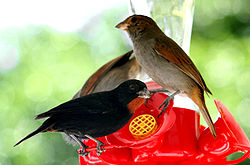Lesser Antillean bullfinch Last updated October 03, 2025 Species of bird
The lesser Antillean bullfinch (Loxigilla noctis bird in the family Thraupidae . It is found in Saint Barth , Saint Martin , Anguilla , Antigua and Barbuda , Dominica , Grenada , Guadeloupe , Martinique , Montserrat , Netherlands Antilles , Saint Kitts and Nevis , Saint Lucia , Saint Vincent and the Grenadines , the British Virgin Islands , and the U.S. Virgin Islands .
Its natural habitats are subtropical or tropical dry forest , subtropical or tropical moist lowland forest , and heavily degraded former forest.
Gallery Male on St. John, USVI
Male on St. John, USVI
Female on St. John, USVI
References ↑ BirdLife International (2018). "Loxigilla noctis " . IUCN Red List of Threatened Species . 2018 e.T22734677A132183438. doi : 10.2305/IUCN.UK.2018-2.RLTS.T22734677A132183438.en . Retrieved 12 November 2021 . ↑ Linnaeus, Carl (1766). Systema naturae: per regna tria natura, secundum classes, ordines, genera, species, cum characteribus, differentiis, synonymis, locis 1, Part 1 (12th ed.). Holmiae (Stockholm): Laurentii Salvii. pp. 320– 321. ↑ Brisson, Mathurin Jacques (1760). Ornithologie, ou, Méthode Contenant la Division des Oiseaux en Ordres, Sections, Genres, Especes & leurs Variétés 3. Paris: Jean-Baptiste Bauche. pp. 118– 119, Plate 7 fig. 1. ↑ Jobling, James A. (2010). The Helm Dictionary of Scientific Bird Names . London: Christopher Helm. p. 274. ISBN 978-1-4081-2501-4 ↑ Lesson, René (1831). Traité d'Ornithologie, ou Tableau Méthodique 443. 1 2 Gill, Frank ; Donsker, David; Rasmussen, Pamela , eds. (July 2020). "Tanagers and allies" . IOC World Bird List Version 10.2 . International Ornithologists' Union. Retrieved 27 November 2020 . ↑ Buckley, P.A.; Buckley, F.G. (2004). "Rapid speciation by a Lesser Antillean endemic, Barbados Bullfinch Loxigilla barbadensis " . Bulletin of the British Ornithologists' Club . 125 : 108– 123. ↑ Banks, R.C.; Cicero, C.; Dunn, J.L.; Kratter, A.W.; Rasmussen, P.C.; Remsen, J.V.; Rising, J.D.; Stotz, D.F. (2006). "Forty-Seventh Supplement to the American Ornithologists' Union Check-List of North American Birds" . The Auk . 123 (3): 926– 936. doi : 10.1093/auk/123.3.926 . This page is based on this
Wikipedia article Text is available under the
CC BY-SA 4.0 license; additional terms may apply.
Images, videos and audio are available under their respective licenses.






